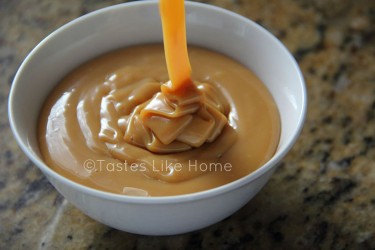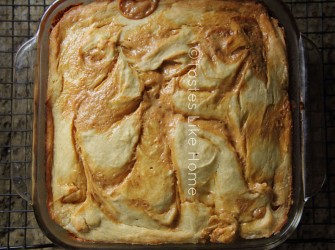Hi Everyone, Jam is a condiment that is made with fruit that is cooked low and slow, with sugar, until it becomes thick, fruity and sweet. Now, instead of fruit, imagine milk that is sweetened and cooked just as slowly for a very long time, and you will end up with milk jam. That is what dulce de leche is, milk jam, candy of milk or caramelized milk. It is one of the most decadent things you will ever come across in the realm of sweetness.
Dulce de leche is known worldwide but it is in South America and the Spanish-speaking Caribbean that it is most frequently used. From Mexico in the North to Argentina and Chile in the South, dulce de leche weaves a long, thick trail of candied milk.
 This thick milk caramel is used to flavour candies, cakes, cookies and ice creams. You can find it drizzled over a variety of desserts such as brownies, sweet rolls, pancakes and cheesecakes or sandwiched between cookies. You might have ordered dulce de leche flavoured ice cream or how about coffee flavoured with dulce de leche? The flavour is addictive.
This thick milk caramel is used to flavour candies, cakes, cookies and ice creams. You can find it drizzled over a variety of desserts such as brownies, sweet rolls, pancakes and cheesecakes or sandwiched between cookies. You might have ordered dulce de leche flavoured ice cream or how about coffee flavoured with dulce de leche? The flavour is addictive.
Although you can buy dulce de leche in a can or jar, there is really no need to do so because making your own at home is rather easy. Not quick, but easy. All you have to do is pop a can of condensed milk into a pot with water, bring to boil and then let it simmer for a few hours. The torture is, having to wait for the can to cool before you can get to the gooey goodness. You can make it from scratch by cooking equal parts of milk and sugar together in a pot for long hours. The mixture is constantly stirred to prevent scorching while coaxing the ingredients to thickness. But why do all of that when you’ve got a can of condensed milk?
The long slow cooking of the can of condensed milk, turning it into dulce de leche causes the sweetened milk to change its colour ranging from light to dark brown, and create a flavour that is best understood and appreciated by tasting it. Scientifically speaking two things occur as the cooking takes place – caramelization and the milliard reaction. Caramelization creates flavour and colour. When caramelization occurs, volatile chemicals in the food are released producing the characteristic flavour of caramel. Each ingredient that is caramelized will produce its own flavour; therefore, caramelized milk will taste different from caramelized onions or sugar.

Milliard reaction is the result of a chemical interaction between amino acids and reducing sugars (in this case reducing the sweetened milk). Milliard reaction is what causes foods to get brown and give them their desirable flavour. Milk and sugar when combined using caramelization and the Millard reaction create a one-of-a-kind condiment that will sway even those who do not have a sweet tooth.
Making dulce de leche
You can make dulce de leche at home using different methods, in the microwave, in the oven, on the stovetop in a pressure cooker or in a regular pot on the stove. The only method I have used so far is the one on the stovetop in a regular pot, the microwave while quicker sounds a little too attention-getting for me and I don’t know that I have a bowl large enough to prevent spillage. The pressure cooker, while it is a pot with which I am comfortable using, I do not want to put something so sensitive as a sealed can in a pressured environment. However, I do plan to test the oven method the next time I make dulce de leche.
Here’s is what you will need:
- A can of full cream or whole milk condensed milk
- 1 medium-sized deep saucepot
- Water

Here’s what to do:
- Remove the label from the can (this is to avoid it disintegrating into the water and making it murky; besides you don’t need it).
- Punch 2 tiny holes into the top of the can (make them at opposite sides). Some of the milk will pop out; ignore it.
- Put the can into the pot and fill it with tap water until the water comes about ½-inch shy of the top of the can. Place the pot with can on medium heat and bring it to a boil then reduce the heat to low and simmer for 3 – 4 hours. You will need to keep some hot water on hand so that you can replenish water that has evaporated. It is important to maintain the level of water about ½ inch from the top of the can to ensure even heating. During the time of cooking, you may hear the can jiggling a little in the pot, that’s quite normal.
- When the time is up, carefully remove the can from the hot water and place on a wire rack to cool completely.
- Open the can completely and discard the cover. Stir vigorously to mix or pour the mixture into a bowl and whisk well to mix uniformly. Transfer to an airtight glass jar and store in the refrigerator.
- Use according to recipe calling for dulce de leche, to sweeten your coffee or just get a teaspoon and indulge.
Here are some things to note:
- Some condensed milk are made with more water than others so the cooking time for the milk to concentrate to become dulce de leche would vary, hence the timing of 3 – 4 hours.
- The suggested timing also has to do with the desired consistency for the dulce de leche, some people like theirs darker while others like it lighter. If cooked beyond 4 hours, you will find that the dulce de leche becomes firmer. When it is firmer, it holds well when sandwiched between cookies or to put as nuggets in homemade ice cream.
- Do not attempt to open the can before it is completely cooled.
Have a sweet day.
Cynthia









